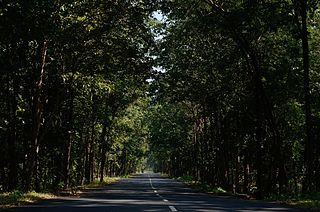
The State Emergency Service (SES) is the name used by a number of volunteer organisations in Australia that provide assistance during and after major incidents. Specifically, the service deals with floods, storms and tsunamis, but can also assist in other emergencies, such as vertical and road crash rescues, missing persons searches, and medical evacuations. In other scenarios the SES may provide a support role to other agencies, particularly police and fire. The SES is operational 24 hours a day. The SES is constituted as separate organisations operating in the various Australian states and territories. Eight of the SES organisations co-ordinate through the Australian Council of State and Territory Emergency Services (ACSES).

Soil salinity and dryland salinity are two problems degrading the environment of Australia. Salinity is a concern in most states, but especially in the south-west of Western Australia.

Conservation Volunteers Australia is an Australian not-for-profit conservation organisation that attracts and co-ordinates volunteers for environmental restoration projects.

The Australian Conservation Foundation (ACF) is Australia's national environmental organisation. ACF is a community of over 400,000 people who speak out, show up and act for a world where forests, rivers, people and wildlife thrive. Founded in 1965, ACF has been a powerful voice for the environment for more than 50 years. It is an independent, non-partisan, non-profit organisation focused on advocacy, policy, research and community organising.
The Murri is a demonym for Indigenous Australians of modern-day Queensland and north-west New South Wales. For some people and organisations, the use of indigenous language regional terms is an expression of pride in their heritage. The term includes many ethno-linguistic groups within the area,such as the Kamilaroi (Gamilaraay) and Yuggera (Jagera) peoples.
Manly Vale is a suburb of northern Sydney, in the state of New South Wales, Australia 17 kilometres north-east of the Sydney central business district in the local government area of Northern Beaches Council, in the Northern Beaches region.
Richard Andrew Farley was an Australian born journalist, politician, land rights and civil rights activist for the rights of Indigenous Australians. He emerged in the public's eye as a prominent member of the Council for Aboriginal Reconciliation, an organisation that looked to establish healthy, multicultural relationships between Aboriginal and Torres Strait Islanders and non-Indigenous Australians.

The Wildlife Preservation Society of Queensland based in Queensland, Australia is a not-for-profit organisation which aims to engage communities to deliver conservation outcomes.
The Queensland Conservation Council (QCC) or Queensland Conservation is a non-governmental organisation that represents all the major conservation organisations of Queensland state in Australia. The organisation have been working to protect, conserve and sustain Queensland’s unique natural environment since 1969. The organisation's office is currently located in West End, Brisbane.

Social forestry is the management and protection of forest and afforestation of barren and deforested lands with the purpose of helping environmental, social and rural development.
Bush Heritage Australia is a non-profit organisation based in Melbourne, Australia, that operates throughout Australia. It was previously known as the Australian Bush Heritage Fund, which is still its legal name. It purchases land, assessed as being of outstanding conservation value, from private owners, to manage as wildlife reserves in perpetuity. It also partners with existing land owners, including Aboriginal groups, to help plan and manage conservation work of important landscapes. It does so to protect endangered species and preserve Australia's biodiversity. By 2019 the organisation was contributing to the protection of 11.3 million hectares on its reserves and partnership lands. There were 6,359 Australian species recorded on their reserves and partnership properties, including 243 threatened species.

An Indigenous Protected Area is a class of protected area used in Australia formed by agreement with Indigenous Australians, declared by Indigenous Australians, and formally recognised by the Australian Government as being part of its National Reserve System.
The Conservation Council of South Australia is an environmental organisation serving as a peak body, representing over 50 member groups. Combined, these groups represent over 90,000 South Australians with the common goals being the conservation and protection of the environment and a sustainable future.

Bushfires in Australia are common, impact extensive areas, and can cause property damage and loss of human life. However, certain native flora in Australia have evolved to rely on bushfires as a means of reproduction, and fire events are an interwoven and an essential part of the ecology of the continent. For thousands of years, Indigenous Australians have used fire to foster grasslands for hunting and to clear tracks through dense vegetation.

Beginning as a conservation movement, the environmental movement in Australia was the first in the world to become a political movement. Australia was home to the world's first Green party.
The Queen's Birthday Honours 2009 were appointments Australian honours system to recognise and reward good works by citizens of Australia and other nations that contribute to Australia. The Birthday Honours are awarded as part of the Queen's Official Birthday celebrations and were announced on 8 June 2009 in Australia.
Phillip Toyne AO was an Australian environmental and indigenous rights activist, lawyer, and founder of Landcare Australia. He was the head of the Australian Conservation Foundation from 1986 to 1992. He negotiated the Pitjantjatjara Land Rights Act and the successful native title claim of the traditional owners of Uluru in 1983.
Sea Spurge Remote Area Teams (SPRATS) is an environment care group founded in 2007, using a volunteer adventure conservation model. The initial primary purpose of the group, made up of a number of teams, is to remove the invasive sea spurge flowering plant.
Heather Mary Mitchell, neeHutchieson was an Australian farmer, community leader and conservationist. From 1986 to 1989, she served as the first female president of the Victorian Farmers Federation, and played a central role in the establishment of Landcare.









